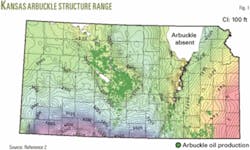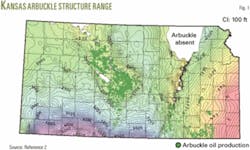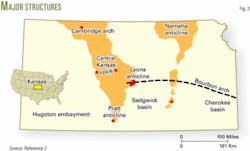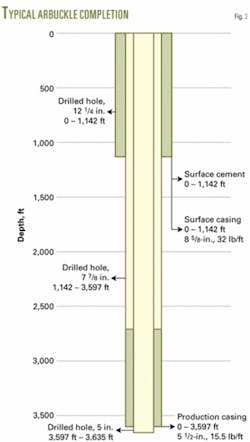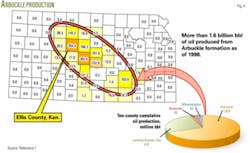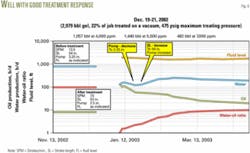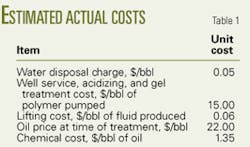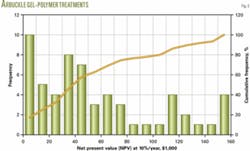Gel-polymer extends Arbuckle high-water-cut well life
Arbuckle wells provide a good example of how the use of gelled polymer technology can extend the life of high water-cut wells. The treatments studied obtained substantial amounts of incremental oil with reduced water production.
The study showed that treatments in 89% of wells were economically successful at a $22/bbl oil price.
With the current higher oil price, operators will likely expand the use of gel-polymer technology.
Gel-polymer treatments
Operators perform gel-polymer treatments when water production becomes a major concern. This was the case in central Kansas where various operators recently have completed many successful polymer jobs in an attempt to shut off unwanted water and increase oil production.
The majority of these jobs were in wells producing from the Arbuckle formation (Fig. 1). Arbuckle reservoirs typically are characterized as an oil column on top of a strong aquifer that results in water coning and a high water-oil ratio.1
This article reviews the results of an economic analysis conducted for 59 wells in which production wells were treated with a chrome acetate-polyacrylamide gelant.
Arbuckle production
The Arbuckle formation covers much of the central Kansas uplift (CKU). Fig. 2 shows a map of Kansas and its major structural elements.
A common perception about the Arbuckle is that it is a fracture-controlled dolomite reservoir and that basement structure patterns enhanced by subaerial exposure influence both reservoir porosity and permeability.2
A common belief is that the typical Arbuckle formation contains oil and gas only in the top 25-50 ft. Consequently, operators have completed Arbuckle wells historically only in the top few feet (Fig. 3).
Arbuckle wells have had prolific and long production histories. First oil production started in the 1920s and most Arbuckle reservoirs were drilled before 1955. One estimate is that Arbuckle reservoirs in Kansas have produced about 2.2 billion bbl of oil, representing about 36% of total Kansas oil production to date.3
About 69% (1.63 billion bbl) of all Arbuckle production has come from 10 counties on the Central Kansas Uplift (Fig. 4). The Arbuckle wells produce relatively high fluid volumes, greater than 1,000 b/d with 1% oil or less.
Features such as fractures, connected vugs, and high-permeability dolomite matrix rock control the oil production and fluid flow. Initially oil filled these void space features when Arbuckle production began and the wells produced at very high oil flow rates with little water.
As oil production proceeded and drawdown pressure increased, however, water quickly replaced oil flow. This water is believed to come from a large underlying aquifer, via large void space features or fractures. As a result, water production rates increase rapidly with time, which leads to a declining oil rate.
This general behavior has led operators to implement gel-polymer treatments to shut off unwanted water and improve oil recovery.
TORP interactive database
The Tertiary Oil Recovery Project (TORP) at the University of Kansas has established a gelled polymer treatment web-based database that links to the Kansas Geological Survey (KGS)’s Oracle database.
TORP’s goal is to develop a database on the performance of Arbuckle and related gel-polymer treatments. This will assist geologists, engineers, and oil operators in studies aimed at a better understanding of how and where to apply this technology. Also, operators can use the database to evaluate past gel-polymer treatments within their active production areas.
One can access the interactive gel-polymer website through TORP’s website (www.TORP.ku.edu). The treatment page gives data such as:4
• Names of the oil company and vendor that conducted the treatment.
• Treatment location by field and county.
• Well name and location.
• Pertinent wellbore information, such as PBTD and TD.
• Volume of pretreatment acid job.
• Volume of polymer injected.
• Volume of oil produced from the well after the treatment.
• Incremental volume of reduced water production resulting from the treatment.
• Calculated payout time of the treatment.
In some cases, actual field information contains detailed treating reports from the vendors or treating pressure data and pre and posttreatment build-up data. Also, the page provides a link to KGS’s Oracle database that contains additional well information.
Currently, the total treatment information in the database is for 84 wells. The economic analysis of the gelled polymer treatment process applied in the Arbuckle formation, discussed in this article, included information from the database on 59 treated wells.
Polymer gels
Operators have applied two chemical technologies in the Arbuckle gel-polymer treatments. The first is the MARCIT technology in which dry polymer is mixed in solution water at the surface and crosslinked with chromium triacetate in situ.
Marathon Oil Co. developed this gel (Cr(III)-carboxylate/acrylamide-polymer) in the mid 1980s.5 MARCIT is the acronym for Marathon conformance improvement treatment.
In this study, 80% of the wells were treated with this system. Recent treatment volumes range from 1,500 to 5,000 bbl of polymer.
The second system uses Chevron-Phillips Chemical Co. technology referred to as the PROD system. This system also uses chromium III with chromium propionate as the crosslinker and uses liquid instead of dry polymer.
The remaining 20% of the 59 wells in this study were treated with this system.
Example treatments
Most of the wells studied (89%) responded favorably to the treatment, yielding a positive economic return. In some cases, oil production increased to more than 100 bo/d from about 2 bo/d (pretreatment) for several days after the treatment, with production sustained above the pretreatment level for 6 months or more.
Typically the wells saw a significant drop in water production, for example, to 70 bw/d from an initial 700 bw/d. Also the water rates remained lower for a long time.
Fig. 5 shows one example of a good response. Before the treatment, this well produced 8 bo/d and 700 bw/d with a producing fluid level of 1,100 ft above the perforations.
The treatment, performed in December 2002, included a 2,979-bbl gel solution. Early in the injection process, the well showed little resistance to the treatment with 22% of the job completed on a vacuum at surface. As the gel solution injection proceeded, however, the flow resistance increased and the treatment required a high pressure to sustain the designed injection rate. The treatment had a maximum recorded treating pressure of 475 psig at surface.
The operator returned the well to production after a 15-day shutin to allow the gel to form.
The initial production following the treatment was 130 bo/d and 130 bw/d. One month later, it was 45 bo/d and 129 bw/d, and 6 months later it was 13 bo/d and 236 bw/d. As production continued, the oil rate decreased exponentially and the water rate increased.
For most wells with unfavorable treatment results, the oil-rate increase or water-rate decrease lasted for only a short period. A couple of wells in the database responded poorly to the treatment, with posttreatment oil rates that were lower than pretreatment rates.6
Economic evaluation
Individual well economics vary from well to well depending on reservoir quality, polymer volume, posttreatment oil and water production rates, and operating costs that include lifting, disposal, chemical, electrical, and equipment costs.
Table 1 lists the average costs derived from the estimated economic parameters.
Average costs included a $1,400/well/month lifting cost, which results in a $0.06/bbl lifting cost if one assumes an 800-b/d fluid production. The current $0.05/bbl surface-water handling and discharge cost was the basis for the estimated water-disposal cost. The estimated chemical cost for corrosion inhibitors was $1.35/bbl of oil produced.7 The analysis did not include any inflation factor.
The economic analysis covered the 1-year posttreatment period and included a 10% discount rate and a constant $22/bbl oil price, the approximate price at the time most of the wells were treated.
Table 2 presents an example of the discounted cash-flow analysis for wells treated with gelled polymer.
The study analyzed the economics for each well separately on a monthly basis. For wells with posttreatment production data of only 6 months or less, the study included a decline curve analysis to predict production rates for a 12-month period. This analysis used an exponential type curve to predict the oil production rate and a linear extrapolation to determine the water production rate.
Fig. 6 shows a frequency plot based on the analysis of all of the gel treatments. This bar graph indicates that 49 of the 59 wells studied had a positive NPV and about one-half had an NPV of $40,000 or more.
The average cumulative incremental oil production after 1-year posttreatment was 3,994 bbl/well (median of 3,329 bbl/well).
The average cumulative reduction in water production was about 291,000 bbl (median of 202,000 bbl).
The dollar value to the operators of the incremental oil production was a factor of about three times greater than the value of decreased water production.
Acknowledgment
The authors thank Kansas oil operators and gel vendors for providing data and other information on the Arbuckle gel-polymer treatments. ✦
References
1. Reynolds, R.R., “Gel Polymer Treatments in Kansas Arbuckle Wells,” North Mid-Continent Region for Petroleum Technology Transfer Council’s website, http://www.nmcpttc.org/Case_Studies/GelPolymer/index.html.
2. Franseen, E.K., et al., “Geologic Characteristics of Arbuckle Reservoirs in Kansas,” Tertiary Oil Recovery Project’s Fifteenth Oil Recovery Conference Proceedings, Wichita, Kan., Mar. 12-13, 2003.
3. Portwood, J.T., “The Kansas Arbuckle Formation: Performance Evaluation and Lessons Learned from More Than 200 Polymer-Gel Water-Shutoff Treatments,” Paper No. SPE 94096, SPE Production and Operations Symposium, Oklahoma City, Apr. 17-19, 2005.
4. Pancake, R.E., “TORP Interactive Arbuckle Gel Polymer Treatment Website,” Tertiary Oil Recovery Project’s Sixteenth Oil Recovery Conference Proceedings, Wichita, Kan., Apr. 6-7, 2005.
5. Sydansk, R.D., “New Conformance-Improvement-Treatment Chromium (III) Gel Technology,” Paper No. SPE/DOE 17329, SPE/DOE Enhanced Oil Recovery Symposium, Tulsa, Apr. 17-20, 1988.
6. Willhite, G.P., and Pancake, R.E., “Controlling Water Production Using Gelled Polymer Systems,” Paper No. SPE 89464, SPE/DOE Fourteenth Symposium on Improved Oil Recovery Tulsa, Apr. 17-21, 2004.
7. Personal communication with Kansas oil operators.
The authors
Maubarak M. Alhajeri ([email protected]) is a graduate student in chemical and petroleum engineering at the University of Kansas. He previously worked for Schlumberger Oil Field Services. Alhajeri has a BS in petroleum engineering from the University of Kansas. He is an SPE member.
Don W. Green ([email protected]) is a professor of chemical and petroleum engineering at the University of Kansas and is also co-director of the Tertiary Oil Recovery Project. He previously worked for Continental Oil Co. Green holds a BS in petroleum engineering from the University of Tulsa and an MS and PhD in chemical engineering from the University of Oklahoma. He is member of SPE, AIChE, and the American Society for Engineering Education (ASEE).
Jenn-Tai Liang ([email protected]) is associate professor of chemical and petroleum engineering at the University of Kansas. He previous worked at the Idaho National Engineering and Environmental Laboratory and at New Mexico Institute of Mining and Technology. Liang has a BS in chemistry from Tamkang University, Taiwan, an MS in petroleum engineering from the University of Alabama, and a PhD in petroleum engineering from the University of Texas. Liang is an SPE member.
Richard E. Pancake (pancake @ku.edu) is EOR/field liaison engineer for the Tertiary Oil Recovery Project at the University of Kansas. He previously worked for F. G. Holl Co., Wichita, Kansas, and Mobil Oil Corp. Pancake has a BS in petroleum engineering and an MS in environmental engineering from the University of Kansas. Pancake is an SPE member.
